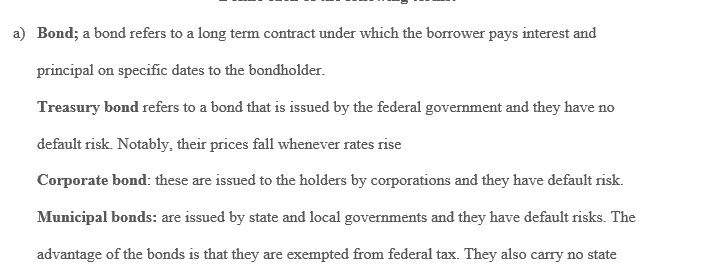The rate of return on a bond
(5-1)
Define each of the following terms:
Bond; Treasury bond; corporate bond; municipal bond; foreign bond
Par value; maturity date; coupon payment; coupon interest rate
Floating-rate bond; zero coupon bond; original issue discount bond (OID)
Call provision; redeemable bond; sinking fund
Convertible bond; warrant; income bond; indexed bond (also called a purchasing power bond)
Premium bond; discount bond
Current yield (on a bond); yield to maturity (YTM); yield to call (YTC)
Indentures; mortgage bond; debenture; subordinated debenture
Development bond; municipal bond insurance; junk bond; investment-grade bond
Real risk-free rate of interest, ; nominal risk-free rate of interest,
Inflation premium (IP); default risk premium (DRP); liquidity; liquidity premium (LP)
Interest rate risk; maturity risk premium (MRP); reinvestment rate risk
Term structure of interest rates; yield curve
“Normal” yield curve; inverted (“abnormal”) yield curve
(5-2)
“Short-term interest rates are more volatile than long-term interest rates, so short-term bond prices are more sensitive to interest rate changes than are long-term bond prices.” Is this statement true or false? Explain.
(5-3)
The rate of return on a bond held to its maturity date is called the bond’s yield to maturity. If interest rates in the economy rise after a bond has been issued, what will happen to the bond’s price and to its YTM? Does the length of time to maturity affect the extent to which a given change in interest rates will affect the bond’s price? Why or why not?
(5-4)
If you buy a callable bond and interest rates decline, will the value of your bond rise by as much as it would have risen if the bond had not been callable? Explain.
(5-5)
A sinking fund can be set up in one of two ways. Discuss the advantages and disadvantages of each procedure from the viewpoint of both the firm and its bondholder
Answer preview to the rate of return on a bond
APA
1122 words



